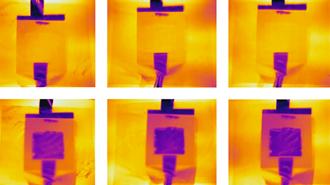The comfortable temperatures of our indoor spaces feel so natural to us, we rarely consider just how monumental a task it is to maintain “room temperature” as the weather and seasons change. Where 30% of all the world’s energy is consumed by buildings, nearly half of this goes directly into heating and cooling.
As climate change exacerbates both the frequency and severity of extreme weather, this consumption is only expected to rise. Prolonged summer heatwaves and extreme cold snaps in winter will put increasing strain on heating and air conditioning systems, raising energy consumption, and its resulting impact on the climate, even further.
The challenge: In the face of this spiraling problem, many researchers are now dedicated to developing smarter insulating materials, with molecular properties that can reflect or absorb heat without expending energy.
One effect currently being explored, called “electrochromism,” involves materials that can reversibly change color when stimulated by electrical currents.
So far, this research has mainly focused on tuning between colors at visible wavelengths. However, since most heat is radiated at infrared wavelengths at room temperature, existing electrochromic materials are not ideally suited to insulating buildings.
In one state, the material absorbs up to 90% of infrared radiation.
An “infrared thermostat”: A team of US researchers has now developed a new electrochromic material, which can be stimulated to reflect or absorb varying amounts of infrared radiation.
Headed by Po-Chun Hsu at the University of Chicago, the team’s design features a copper-based aqueous solution, which strongly emits infrared radiation. This liquid is sandwiched between a metal foil and a transparent sheet of graphene, coated with platinum nanoparticles.
When the graphene electrode becomes negatively charged, it draws in positive copper ions from the solution, which deposit themselves onto the graphene to form a thin, solid film. In this state, the material absorbs up to 90% of incoming infrared radiation, setting it to “heating mode.”
It requires only a tiny fraction of the energy it saves.
When the electrodes’ charges are reversed, the deposited copper is stripped away from the graphene. Back in its original state, the liquid solution absorbs just 7% of incoming infrared radiation, setting the material to its “cooling mode.”
By varying the difference in charge between the two electrodes, Hsu’s team could carefully control the transparency of the deposited copper layer, allowing them to fine-tune the amount of infrared radiation it absorbs.
Saving power: While a little power is required to change the charge of the electrodes, it is just a small fraction of the energy the material absorbs in cold weather or reflects on hot days.
In addition, the team’s design is highly resilient to wear-and-tear: its performance held up even after 2,5000 cycles of copper deposition and stripping.
Deploying the tech wouldn’t require any major upheaval to current building practices.
Although these initial experiments only examined material samples a few centimeters in size, Hsu and his colleagues hope that in the near future, their design could be tiled into sheets large enough to cover entire buildings. They calculate that such highly tunable insulation could save some 8.4% of all the energy consumed annually by heating and air conditioning systems in US buildings.
If their design is rolled out commercially in the future, the team suggests that it wouldn’t require any major upheaval to current building practices, and could even be retrofitted onto poorly insulated buildings. When encased in a transparent plastic film, the tiles could be coated in paints or other materials which are invisible to infrared wavelengths – allowing them to maintain their heating and cooling performance, without damaging the aesthetics of buildings.
Insulation in a changing climate: Through further improvements, Hsu’s team ultimately hope that their innovation could help to protect us against extreme swings in temperature that climate scientists predict in the coming decades.
By taking some of the strain off active heating and air conditioning systems, the technology may soon contribute to keeping indoor spaces at safe and comfortable temperatures, without contributing further to global heating.
We’d love to hear from you! If you have a comment about this article or if you have a tip for a future Freethink story, please email us at [email protected].






